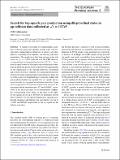| dc.contributor.author | Sirunyan, A. M | |
| dc.contributor.author | Tumasyan, A. | |
| dc.contributor.author | Adam, W. | |
| dc.contributor.author | Ambrogi, F. | |
| dc.contributor.author | Bergauer, T. | |
| dc.contributor.author | Dragicevic, M. | |
| dc.contributor.author | Erö, J. | |
| dc.contributor.author | Valle, A. E D | |
| dc.contributor.author | Frühwirth, R. | |
| dc.contributor.author | Jeitler, M. | |
| dc.contributor.author | Krammer, N. | |
| dc.contributor.author | Lechner, L. | |
| dc.contributor.author | Liko, D. | |
| dc.contributor.author | Madlener, T. | |
| dc.contributor.author | Mikulec, I. | |
| dc.contributor.author | Pitters, F. M | |
| dc.contributor.author | Rad, N. | |
| dc.contributor.author | Schieck, J. | |
| dc.contributor.author | Schöfbeck, R. | |
| dc.contributor.author | Spanring, M. | |
| dc.date.accessioned | 2021-09-20T17:41:49Z | |
| dc.date.available | 2021-09-20T17:41:49Z | |
| dc.date.issued | 2021-01-05 | |
| dc.identifier.uri | https://hdl.handle.net/1721.1/132079 | |
| dc.description.abstract | Abstract
A search is presented for supersymmetric partners of the top quark (top squarks) in final states with two oppositely charged leptons (electrons or muons), jets identified as originating from
$${\text {b}}$$
b
quarks, and missing transverse momentum. The search uses data from proton-proton collisions at
$$\sqrt{s}=13\,\text {TeV} $$
s
=
13
TeV
collected with the CMS detector, corresponding to an integrated luminosity of 137
$$\,{\text {fb}}^{-1}$$
fb
-
1
. Hypothetical signal events are efficiently separated from the dominant top quark pair production background with requirements on the significance of the missing transverse momentum and on transverse mass variables. No significant deviation is observed from the expected background. Exclusion limits are set in the context of simplified supersymmetric models with pair-produced lightest top squarks. For top squarks decaying exclusively to a top quark and a lightest neutralino, lower limits are placed at
$$95\%$$
95
%
confidence level on the masses of the top squark and the neutralino up to 925 and 450
$$\,\text {GeV}$$
GeV
, respectively. If the decay proceeds via an intermediate chargino, the corresponding lower limits on the mass of the lightest top squark are set up to 850
$$\,\text {GeV}$$
GeV
for neutralino masses below 420
$$\,\text {GeV}$$
GeV
. For top squarks undergoing a cascade decay through charginos and sleptons, the mass limits reach up to 1.4
$$\,\text {TeV}$$
TeV
and 900
$$\,\text {GeV}$$
GeV
respectively for the top squark and the lightest neutralino. | en_US |
| dc.publisher | Springer Berlin Heidelberg | en_US |
| dc.relation.isversionof | https://doi.org/10.1140/epjc/s10052-020-08701-5 | en_US |
| dc.rights | Creative Commons Attribution | en_US |
| dc.rights.uri | https://creativecommons.org/licenses/by/4.0/ | en_US |
| dc.source | Springer Berlin Heidelberg | en_US |
| dc.title | Search for top squark pair production using dilepton final states in $${\text {p}}{\text {p}}$$ pp collision data collected at $$\sqrt{s}=13\,\text {TeV} $$ s = 13 TeV | en_US |
| dc.type | Article | en_US |
| dc.identifier.citation | The European Physical Journal C. 2021 Jan 05;81(1):3 | en_US |
| dc.contributor.department | Massachusetts Institute of Technology. Department of Physics | |
| dc.identifier.mitlicense | PUBLISHER_CC | |
| dc.eprint.version | Final published version | en_US |
| dc.type.uri | http://purl.org/eprint/type/JournalArticle | en_US |
| eprint.status | http://purl.org/eprint/status/PeerReviewed | en_US |
| dc.date.updated | 2021-03-28T03:20:26Z | |
| dc.language.rfc3066 | en | |
| dc.rights.holder | CERN for the benefit of the CMS collaboration | |
| dspace.embargo.terms | N | |
| dspace.date.submission | 2021-03-28T03:20:26Z | |
| mit.license | PUBLISHER_CC | |
| mit.metadata.status | Authority Work and Publication Information Needed | |
